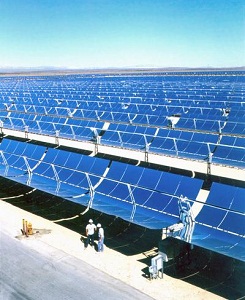Understanding Solar Thermal Energy
 Solar thermal energy is the collection of the sun’s heat for human use. It’s unlike photovoltaic (PV) power, which converts a portion of the sun’s electromagnetic radiation directly to electrons and electricity. Solar thermal has a broader range of uses than PV does, since the sun’s heat can be collected and transferred in a medium, and that stored energy is then used for purposes including heating and cooling a home, heating water, cooking food, or creating electricity. The first two uses are generally suitable for homes, as is generating electricity, but the latter is usually done on the commercial scale.
Solar thermal energy is the collection of the sun’s heat for human use. It’s unlike photovoltaic (PV) power, which converts a portion of the sun’s electromagnetic radiation directly to electrons and electricity. Solar thermal has a broader range of uses than PV does, since the sun’s heat can be collected and transferred in a medium, and that stored energy is then used for purposes including heating and cooling a home, heating water, cooking food, or creating electricity. The first two uses are generally suitable for homes, as is generating electricity, but the latter is usually done on the commercial scale.
Three ranges of solar thermal energy are used: low-temperature, which is used for heating cooling and ventilation; mid-temperature, which is used for cooking, hot-water heating, and other purposes in the mid-heat range; and high-temperature, which includes generating electricity. Within the broader spectrum of generating electricity, there are various means of focusing the sun’s heat to create electricity through a heat exchanger that superheats water or an inert gas to power a electricity-generating turbine, or a Stirling engine to produce electricity.
The first large-scale solar thermal electricity generators used a mirror-faced reflective parabolic trough to concentrate solar energy on a tube filled with a liquid like antifreeze, water, or synthetic oil. The trough reflects the sun’s heat back onto the tube and heats the liquid inside the tubes. The heated liquid is cycled through to a heat exchanger. There the hot liquid turns water into pressurized steam which pushes a turbine, producing electricity.
To maximize their output, the tubes are surrounded by evacuated glass tubes, which helps them absorb more heat energy and keeps them from reradiating the heat energy. The troughs usually are oriented north to south and follow the sun’s travels throughout the day. To maximize the amount of electricity such a system produces, excess heat is stored in super-insulated tanks filled with molten salt or graphite (both are excellent at retaining heat) and then used to keep the turbines running throughout the night.
The largest solar power plant in the world, PV or otherwise is the Solar Energy Generating System (SEGS) in California. Nine solar thermal plants make up SEGS and have a total capacity of 350MW, enough to power about 105,000 homes. Though they make up the world’s largest solar power plant, parabolic trough systems are available for rooftop installations, in 4- or 8-foot-wide units. The National Renewable Energy Laboratory’s solar resource maps or your local installer will help you decide if you’re in a good place for solar thermal power.



